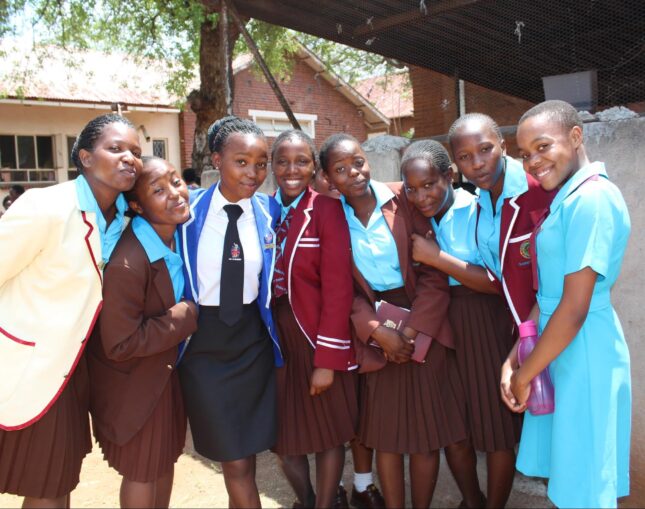-
World AIDS Day: Center Women and Girls to Eradicate AIDS
November 27, 2024 By Deekshita Ramanarayanan
Over the last four decades, contracting HIV has been transformed from a fatal diagnosis to a manageable chronic illness. Political will and financial commitments have reduced new HIV infections worldwide by 39 percent since 2010. However, much work still is needed to meet global targets of preventing new cases of HIV and reducing AIDS-related deaths. Marginalized communities, including women and girls, face countless barriers which hinder progress towards comprehensive HIV prevention across the planet.
Since 1988, December 1 has been designated as World AIDS Day. It is an annual opportunity to raise awareness about HIV & AIDS, as well as encourage progress towards prevention, treatment, and care worldwide. The theme for the 2024 commemoration—“Take the rights path”— is a call for global actors to adopt a human rights approach to addressing inequalities that hold back progress towards ending AIDS. Indeed, gender inequality remains one of the most significant barriers to these goals. Women and girls made up 62% of new HIV infections in Sub-Saharan Africa in 2023, and 44% of new worldwide infections.
Gender inequality presents barriers to women’s active participation in society at economic, social, and cultural levels. Unequal societies often offer women and girls less education about HIV, which contributes to a lack of bodily autonomy and limits agency to negotiate safer sex practices with partners. Adolescent girls and young women face a particularly heightened risk of contracting HIV due to a higher likelihood of having older sexual partners, as well as the prevalence of harmful practices such as child marriage.
Stigma is also a key issue. Gender-based violence and intimate partner violence perpetuates and exacerbates the stigma that women face in accessing HIV prevention and receiving treatment, or even disclosing their HIV status. Stigma related to HIV is also highly prevalent during pregnancy—and pregnant and breastfeeding people living with HIV or trying to prevent infection may face additional discrimination when engaging with partners or accessing health services.
Legal obstacles, such as laws that criminalize HIV exposure, transmission, or non-disclosure, contribute to stigma and discrimination. Such laws disproportionately impact marginalized communities such as women and girls, and pose barriers to accessing health services to prevent and treat HIV.
Pre-exposure prophylaxis, or PrEP, is a common method of preventing HIV through medication. While oral forms PrEP are highly effective and widely used, women and girls face barriers to adhering to the required daily regimen. Distance from health clinics, stigma associated with using PrEP, and concerns that health care providers lack the training to answer questions about PrEP are key challenges.
However, new innovations in preventing HIV infections do present opportunities to address these challenges. Women-led methods, such as the dapivirine vaginal ring, are highly effective, discreet, and safe for long-term use. The ring is also safe to use with most forms of contraception, allowing women and girls to prevent pregnancy as well as HIV. And the recent clinical trial success of lenacapavir (a twice-yearly injectable drug), as well as ongoing trainings to implement an earlier injectable (cabotegravir) also show promise in expanding reliable options for HIV prevention targeted to women and girls.
Global investment is critical in centering women and girls in the future of HIV-related policy and programs. Notably, US leadership through The President’s Emergency Plan for AIDS Relief (PEPFAR) has been credited with changing the trajectory of the global HIV epidemic. The DREAMS (Determined, Resilient, Empowered, AIDS-free, Mentored, and Safe) Partnership has been instrumental in reducing new HIV diagnoses among adolescent girls and young women by 25% or more in the regions where it is in effect. And the next phase of the partnership, DREAMS NextGen, promises a more nuanced and country-specific approach to empower adolescent girls and young women, combat gender unequal social norms, and reduce the risk of HIV infection.
While the future of PEPFAR is uncertain due to challenges with reauthorization and shifting political landscapes, the present and future challenges—and the successes in meeting them thus far—add urgency and hope to the equation. Centering women and girls in a human-rights based approach to HIV prevention and treatment is vital to making progress towards eradicating AIDS.
Sources: IJID Regions; Johns Hopkins Center for Communications Programs; Journal of Global Health; KFF; PLOS One; PrEP Watch; Public Health; UN; US State Department; WHO.
Photo Credit: Group of adolescent girls and young women in Zimbabwe. Allison DiVincenzo, USAID/flickr.com.
 A Publication of the Stimson Center.
A Publication of the Stimson Center.







